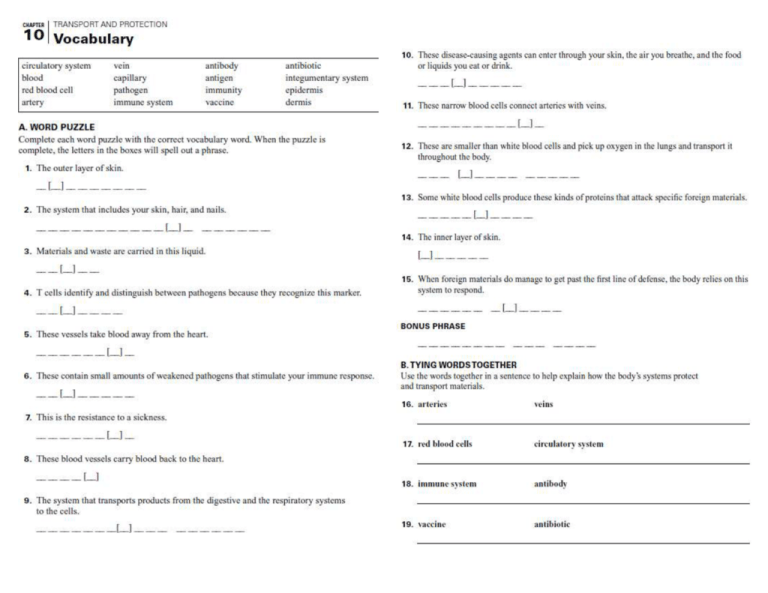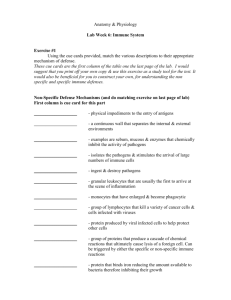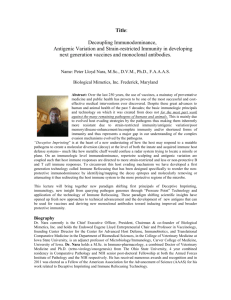Big Idea - Moore Public Schools
advertisement

10.1 Circulatory System 1. The ____________ system transports materials from the digestive system and respiratory system. The digestive system breaks down _________ and _________ and the respiratory The diagram shows a close-up of the flow of blood in a certain area. The arrows show the direction the blood is flowing. For each line, write whether it points to a capillary, an artery, or a vein. Color the artery blood red, the vein blood blue, and the capillary blood purple. system provides _________ the cells need to release energy and removes _________ and other wastes. 2. Materials and wastes are carried in a fluid called ________. The blood moves through the body delivering _________ and removing _______ and other wastes. 3. The heart functions as ______ _______. The right side pumps blood to the _______ to receive _____ and the left side pumps blood to the ______ _______. Each side of the heart has two __________. 4. Blood is made up of four components; ________, ___________ , ______________, and platelets. White blood cells help fight _______. Red blood cells carry _______ throughout the body. There are more _____ blood cells. Plasma contains _______, glucose, hormones, ________, and other substances dissolved in water. Platelets help form _____ _____ when a blood vessel is injured. 5. Blood moves through blood _______. _______ take blood away from the heart. ______ take blood back to the heart. Oxygen and materials are exchanged in the ________ which connect veins and arteries. 6. Blood exerts pressure on blood vessels. What does low blood pressure mean? _________________________________ 7. Why is high blood pressure a serious medical condition? _________________________________________________ _________________________________________________ 8. What are the four blood types? _____________________________ 9. Explain what will happen if a person with Type A blood receives blood from a Type B donor. _________________________________________________ _________________________________________________ 10. If you needed a blood transfusion, and you had type O blood, what type(s) of blood could you receive? _________________________________________________ 11. If you had type AB blood to what blood type(s) could you donate blood to? _________________________________________ Heart From the SMART board, label the parts, draw arrows to indicate blood flow, and color oxygenated blood red and deoxygenated blood blue. Color the cardiac tissue brown. What’s in Your Blood? 1. ___________ __________ _________ patrol tissues and get rid of damaged or dead cells and anything recognized as foreign to the body. Another name for these is _________________. 2. _____________ release substances that start the process of blood clotting. 3. _________ _________________ refers to the amount of blood in a body, averaging 6 to 8 percent of total body weight for an adult. 4. _______________ is mostly water and functions as the medium through which blood cells and platelets are transported through the body. 5. ______ ______________ ____________ are concave disks with a squashed-in center. They transport oxygen and carry away some CO2. They contain ______________________ which is the iron containing pigment that gives them their color. 6. __________________is the average volume of blood contained in an adult. 7. Ninety percent of plasma is made up of ____________. -------------------------------------Answer these questions from your heart notes. 8. Most arteries are oxygen _________. 9. Most veins are oxygen _________ 10. Pulmonary veins are oxygen ________ and the blood is pumped from the _____________. 11. Pulmonary arteries are oxygen _________ and the blood is pumped to the ____________. 12. The aorta sends oxygen __________ blood to the upper body. 4-5 quarts platelets *lungs blood volume *poor water hemoglobin *rich plasma leukocytes red blood cells white blood cells *May be used more than once. 10.2 Immune System 6. Histamine is released when an injury or illness occurs. While slicing vegetables, a chef cut his finger. Where in the chef body is histamine being released? ___________________________ 7. The immune system responds to attack. When we become resistant to a sickness, we say that we are immune. There are two forms of immunity—passive and active. How do you acquire passive immunity? ________________________________________________ 8. What is active immunity? ____________________________ 1. Many systems defend the body from _________ __________. 2. Complete the table below showing how each of the systems defends the body. ________________________________________________ 3. Fill in the Detail Notes 9. Vaccines contain small amounts of ________ or ____________ pathogens that stimulate an immune response. 10. Most diseases can be prevented or treated. How do vaccines help prevent disease? _______________________________ ________________________________________________ 10. 4. What two systems carry white blood cells to an injured or infected area of the body? ________ and ____________ 5. The immune system has response structures and responds to attack. The diagram shows how two types of white blood cells identify and attack pathogens. Identify the T cells and B cell by writing T cell or B cell over the appropriate cell. Fill in the chart. Ways that foreign material enters the body How immune system defends against Wounds Eating and drinking Breathing 11. What are two ways to develop immunity? ___________________ and ______________________. 10.3 Integumentary System 1. Fill in the table. 2. The structure of skin is complex. The skin is made of many structures, which perform many jobs. Label the missing components in the diagram below. 5. Fill in the Table. 6. What happens to the skin as a person grows? ____________ ______________________________________________ 7. The skin grows and heals. Even though the skin protects the body from many pathogens and harmful bacteria, this barrier can be broken. Name four ways the skin barrier be broken. ___________ ___________ _________ __________ 8. What are two things you can do to protect your skin? 3. How many layers does skin have? ______ Which tissue provides temperature protection? _______________ From which layer does hair grow? ___________ 4. A cross section of skin is shown below. ____________is the layer where the skin cells are newest. Color and label the 2 different layers and the hair & oil gland. (4 colors) Which layer protects the body from the environment? _________________ _______________________ ____________________ 9. Read about artificial skin on page 349. What is an advantage and disadvantage of skin transplanted from another place on the body? Ad – less likely to be ______________; Dis – not enough good skin to _________________. 10. What is an advantage and disadvantage of artificial skin? Ad shortened _____________ time; can be used during a ______________. Dis – too _____________ to produce. Do you think burns are more severe if they are limited to the epidermis or if they affect the dermis as well? Why? ________ _________________________________________________ How a Pimple Develops Pimples begin to form when sebum, an oily substance given off by the sebaceous gland, gets trapped beneath the surface of the skin. Color, Label, and put in the correct order, 1, 2, 3. Sweaty Palms and Goose Bumps Your skin aids your body in maintaining a constant temperature. This is an example of _______________________ Label the two pictures either Warm Day or Cool Day. Label the parts of the skin using the word bank. Word Bank blockage pimple epidermis pus hair sebaceous gland hair follicle sebum Label the parts of the Nail. Word Bank bone dead nail fatty tissue nail root nail bed Word Bank Blood vessels Open sweat pore Closed sweat pore Relaxed muscle Contracted muscle sweat Goose bump Sweat gland CH 10 Review 1. Your heart, veins, capillaries, and arteries work together to transport _________________________ 2. Structures that work together as part of the circulatory system include _____________________________________________________________ 3. The cells that deliver oxygen to other cells are _______________________ 4. Force that blood exerts on your arteries is called _____________________ 5. How do pathogens enter your body through the skin? _________________ 6. Mucus traps and destroys pathogens to prevent them from entering the body as part of the defenses of the ________________________________ 7. When foreign material enters the body, one way the immune system responds is by _________________________________________________ 8. Give an example of a nonspecific response in which a tissue responds to irritation or damage. ____________________________________________ 9. When skin gets damaged, the body releases histamines, which cause_________________________________________________________ 10. Redness and swelling of an inflamed area is due to____________________ 11. You develop active immunity to a pathogen by_______________________ 12. Vaccines help your body develop__________________________________ 13. One function of the skin is to______________________________________ 14. What is one function of the integumentary system? ___________________ 15. Which structure in the skin helps control body temperature? ___________ 16. What part of the skin interacts with the nervous system to communicate temperature, pressure, or pain? ___________________________________ 17. One way you can help your skin stay healthy is by_____________________ 18. The skin can easily heal itself from_________________________________ 19. Know the parts of the skin. Lab p _______________ 20. Draw a circle to represent your heart. Divide your circle into four sections. Label the right atrium, the left atrium, the right ventricle, and the left ventricle. Label each chamber as oxygen-poor or oxygen-rich. 21. Draw four arrows to show where blood (1) enters the heart from the lungs, (2) leaves the heart for the body, (3) enters the heart from the body, and (4) leaves the heart for the lungs. Heart










